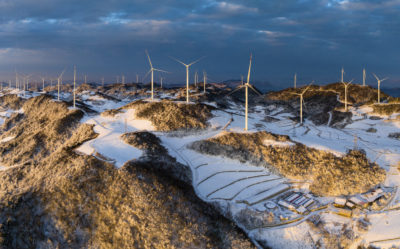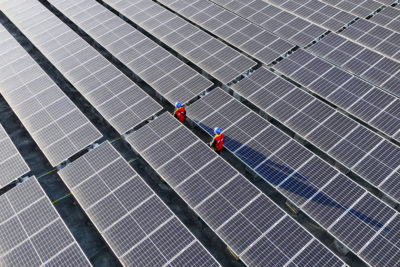[ad_1]
Last November, Chinese climate envoy Xie Zhenhua and U.S. climate envoy John Kerry shook hands on a pledge to triple renewable energy globally by 2030. It was hailed as a welcome revival of climate cooperation between the world’s biggest and second-biggest emitters of greenhouse gases and offered hope that the two veteran climate negotiators had found a way through a blizzard of negative diplomatic exchanges to keep alive the prospects for greater global ambition on tackling climate change.
In one key sector essential to that ambition, however, the Chinese government can argue, with some justification, that it is China, not the United States, that is in the lead. In a world in which national climate targets are being missed, the speed and scale of expansion in China’s installed renewable capacity is unmatched.
In 2020, for example, China pledged to reach 1,200 gigawatts of renewables capacity by 2030, more than double its capacity at that time. At its present pace, it will meet that target by 2025, and could boast as much as 1,000 gigawatts of solar power alone by the end of 2026, an achievement that would make a substantial contribution to the 11,000 gigawatts of installed renewable capacity that the world needs to meet the 2030 targets of the Paris Agreement. Fossil fuels now make up less than half of China’s total installed generation capacity, a dramatic reduction from a decade ago when fossil fuels accounted for two-thirds of its power capacity.
In 2022, China installed roughly as much solar capacity as the rest of the world combined, then doubled additional solar in 2023.
When the International Energy Authority issued its assessment of the pledge to triple renewables globally by 2030, it pointed out that the 50 percent increase in global renewable installations in 2023 was largely driven by China. In 2022, China installed roughly as much solar photovoltaic capacity as the rest of the world combined, then went on in 2023 to double new solar installations, increase new wind capacity by 66 percent, and almost quadruple additions of energy storage.
For the past two decades, China has been notorious as the world’s biggest emitter of greenhouse gases, a country that also uses as much heavily polluting coal as the rest of the world combined. How did it also become the world’s renewable powerhouse?
Part of the answer goes back to investment decisions made in the mid-2000s when China’s decades-long phase of rapid GDP growth was coming to an end. Labor costs were rising, and China’s development model, with its overwhelming dependence on coal, had plunged China into multiple crises of air, soil, and water pollution. In the first decade of this century, China’s emissions more than doubled, and by 2006 it had overtaken the U.S. to earn the unwelcome title of the world’s biggest emitter of greenhouse gases by volume.

A wind farm in Yichang.
Costfoto / NurPhoto / AP Photo
China’s leadership was alert to the negative diplomatic impacts of being the world’s worst polluter, especially in those countries most vulnerable to climate impacts. At the same time, China’s own exposure to climate change effects, on top of its escalating pollution crisis and the public unrest it was generating, was becoming a significant topic in Beijing’s top-level policy discussions. China’s planners were looking for investments that would create an opportunity for a more advanced technological future, and this coincided with the need to clean up China’s environment and the global effort to cut emissions. All this pointed to supporting the development of the renewable technologies the world would need if it was to avoid climate catastrophe.
In the next and every subsequent five-year plan, China made strategic investments in all aspects of renewable technologies, from solar and wind capacity, green hydrogen, and geothermal projects to research and investment in battery storage and its supply chains. In the first phase of its rapid industrial development starting in the 1990s, China had been obliged to license technologies owned by others. Now the strategic ambition was to dominate the field, positioning China as the global supplier of goods to an increasingly carbon-constrained world.
If China has been clear about the opportunity side of climate change, it has been less enthusiastic about cutting its own emissions.
Within a decade, China had largely achieved its goal of dominating not only the production of solar and wind technologies, but it had developed a near monopoly on every aspect of the supply chains, including the mining and processing of the rare-earths and strategic minerals essential for the clean energy revolution. Today, China has more than 80 percent of the world’s solar manufacturing capacity. The extraordinary scale of China’s renewables sector output has driven down prices worldwide, and this is a key factor in reducing the cost barrier to renewable systems for poorer countries. Today China not only holds important positions in wind and battery technologies, but a Chinese company, BYD, has become the world’s biggest EV manufacturer, and China is poised to pose a formidable global challenge in all aspects of electric transportation to established vehicle brands.
But if China has been clear about the opportunity side of climate change, it has been less enthusiastic about cutting its own emissions: In the first two decades of the century, the economy remained overwhelmingly dependent on coal, and China argued that committing to major cuts in emissions would be an unfair constraint on its right to develop. That began to change with President Xi Jinping’s surprise announcement at the 2020 U.N. General Assembly that China would peak its emissions “well before” 2030, as it had promised in Paris in 2015, and in an important new offer, that it would aim for carbon neutrality by 2060. A radical renewables program would be essential to meeting those goals.
Xi Jinping’s announcement attracted global attention, but its most galvanizing effect was at home. It sent a powerful political signal in favor of renewable investments across China, and the nation’s giant state-owned enterprises, including its traditional energy companies, were compelled to take notice, both of Xi’s unequivocal message and the policy initiatives it triggered. The National Energy Administration (NEA), the body that regulates China’s energy sector, also recognized that new policies and mechanisms would be needed if China was to implement Xi’s targets.
Massive wind farms were already operating in northern China, and now a series of utility-scale clean energy bases involving many of China’s massive state-owned utility companies were planned for the relatively empty western desert regions. These bases, a combination of vast solar arrays and wind farms, are to be connected to markets in eastern China through high-speed transmission lines. The projects take advantage both of high solar radiation in the desert and large amounts of cheap, available land. China aims to build more than 200 such bases to help to raise its renewables capacity to about 3.9 terawatts by 2030, more than three times its 2022 total.
China still generates about 70 percent of its electricity from fossil fuels, as renewable energy use lags behind installed capacity.
In addition to these desert projects, the NEA promised in 2021 to improve rural grid transmission and allow village collectives to invest in distributed renewable power and share the benefits. To promote the adoption of distributed rooftop solar, the NEA launched the Whole County PV program, a national pilot scheme that aimed to install photovoltaics in roughly half of China’s county-level rural administrations, comprising about a quarter of China’s population. The program set targets of providing solar to 20 percent of residential properties, with separate targets for commercial buildings.
The utility-scale developments had left out China’s more scattered rural populations, so showing interest in a rural model in which customers both draw energy down and sell energy back to the grid was a radical departure for China’s traditional central planners and grid operators. The NEA now aimed to include China’s neglected rural population in the renewable revolution. By the end of 2022, 676 counties had signed up for the scheme, and more than 51 gigawatts of new distributed solar photovoltaic was installed, nearly half of it on from rural rooftops. In total, by the end of 2022, China had built roughly 157 gigawatts of distributed photovoltaic capacity, more than double that of the U.S.

Workers inspect a rooftop solar array in Fuzhou, China.
Costfoto / NurPhoto via AP
The NEA also announced plans to expand the financing channels for renewables and improve incentives and market mechanisms, aiming to shift the state-owned banks from favoring state-owned enterprises and from undervaluing both the private sector and new policy initiatives.
Today the renewables sector is one of the relatively few bright spots in the Chinese economy, having benefited from a surge in government stimulus as Beijing tried to restore growth hit hard by Covid-19. The massive real estate market, which boosted China’s GDP figures for more than three decades, is teetering on the edge of collapse. The pandemic and the downturn in global economies that followed has hit China’s exports, and nervous Chinese consumers are sitting on their wallets in case things get worse. Renewable energy, however, seems to have a bright future, but fully realizing that potential will demand further radical reforms.
Renewables now account for half of China’s installed capacity, but there has also been a surge in permits for new coal-fired power plants, and China still generates about 70 percent of its electricity from fossil fuels. This means actual renewable energy use is lagging behind installed capacity.
The government has announced plans to create a unified electricity system, merging regional grids into one national market.
This is largely due to problems with China’s giant grid, which prefers high-speed transmission from reliable sources to the challenge of integrating variable renewable power and the associated challenge of matching intermittent supply to demand. For the grid companies, China’s coal-fired power plants are steady and predictable, and they are allowed many more hours of grid access than renewables. In addition, anxieties about energy security are now high on the policy agenda, reinforced by geopolitical tensions and recent droughts that affected hydropower output and resulted in power cuts. In China, energy security still means coal.
China’s current climate and energy ambitions are embedded in a series of policy statements, including its current five-year plan. Although China’s political culture places a heavy premium on meeting its declared goals, a number of energy and climate commitments are currently off target, largely because of the energy sector’s continuing dependence on coal.
In 2021, in the Paris Agreement commitments that China submitted to the U.N., Beijing pledged to “strictly limit” coal growth, strictly control new coal power, reduce energy and carbon intensity by 2025, increase the share of non-fossil energy sources to 20 percent by 2025 and to 25 percent by 2030, and to generate 50 percent of the increase in energy use from 2020 to 2025 from renewable sources. Far from limiting coal growth, however, according to analysis by Carbon Brief, a new coal rush is underway as operators seize what they see as possibly the last opportunity for new plants.

An EV battery factory in Nanjing.
Feature China / Future Publishing via Getty Images
The figures confirm the trend: The average growth rate of coal consumption increased eightfold in the last two years, from 0.5 percent per year between 2016 and 2020 to 3.8 percent per year between 2021 and 2023, and new coal power approvals quadrupled between 2022 and 2023 as compared with the five years before the government pledged its strict controls.
This has contributed to a 12 percent rise in emissions in the energy sector between 2020 and 2023. To meet the government’s 2025 carbon intensity targets, emissions would have to peak this year and decline by 4 to 6 percent by 2025. Some analysts consider these targets already out of reach, but if China is to stay on track with its long- and short-term goals, the government must honor its pledge to control new coal capacity and continue its rapid buildup of renewables.
To use its renewables capacity efficiently however, China has recognized that power system reforms are long overdue. The National Development and Reform Commission recently announced plans to create a unified national power market by 2030, merging its six regional grids into one nationwide electricity market to better manage fluctuations in supply and demand. If that can be achieved, China could not only enhance its position as the global leader in installed capacity for renewable but might also make better use of the clean energy it produces.
[ad_2]
Source link


